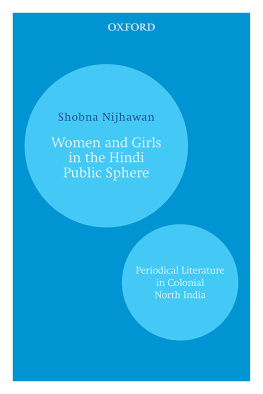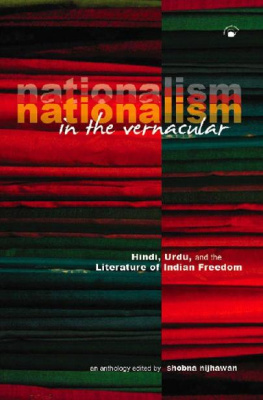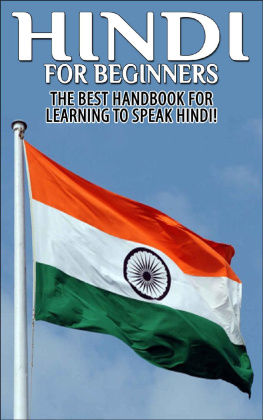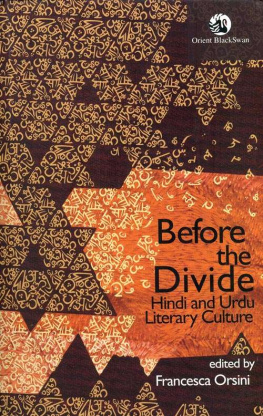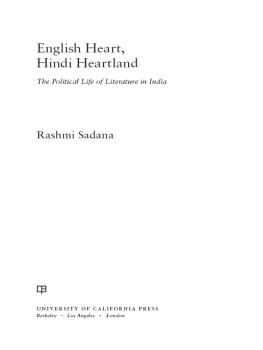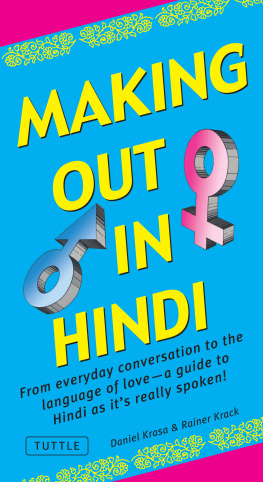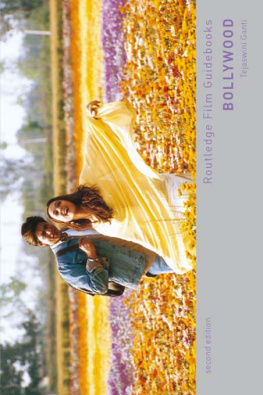Women and Girls
in the Hindi
Public Sphere
Women and Girls
in the Hindi
Public Sphere
Periodical Literature in
Colonial North India
SHOBNA NIJHAWAN


Oxford University Press is a department of the University of Oxford.
It furthers the Universitys objective of excellence in research, scholarship,
and education by publishing worldwide. Oxford is a registered trademark of
Oxford University Press in the UK and in certain other countries
Published in India by
Oxford University Press
YMCA Library Building, 1 Jai Singh Road, New Delhi 110001, India
Oxford University Press 2012
The moral rights of the author have been asserted
First published in 2012
All rights reserved. No part of this publication may be reproduced, stored in
a retrieval system, or transmitted, in any form or by any means, without the
prior permission in writing of Oxford University Press, or as expressly permitted
by law, by licence, or under terms agreed with the appropriate reprographics
rights organization. Enquiries concerning reproduction outside the scope of the
above should be sent to the Rights Department, Oxford University Press,
at the address above
You must not circulate this work in any other form
and you must impose this same condition on any acquirer
ePub ISBN-13: 978-0-19-908854-6
ePub ISBN-10: 0-19-908854-3
Typeset in Adobe Garamond Pro 11/13.2
by Le Studio Graphique, Gurgaon 122 001
Printed in India by Artxel, New Delhi 110 020
To
my parents
Veena and Subhash Chander Nijhawan
Contents
P ART O NE
W OMENS AND G IRLS P ERIODICALS
1. The Periodical as a Genre
An Introduction
P ART T WO
A R EADER
F IGURES
25. Illustrations from Kanya Manoranjan
Top: StoryWhy are you weeping?
(Kanya Manoranjan, November 1913)
Bottom: Prayer (Kanya Manoranjan, December 1913)
26. The honourable Ishvarchandra Vidyasagar
(Kanya Manoranjan, December 1913, inner cover)
B OXES
When I first introduced my project to a librarian at a Hindi archive and told her that I was interested in the literary activities of women in the Hindi public sphere of the early twentieth century, she was surprised by my desire to consult womens periodicals. She politely suggested that it might make more sense to consider another publishing genre carrying real literature. Clearly, she considered periodicals inferior as source material and argued for novels, short stories, and poetry published in monographs and collections. Hers was not a singular voice. Yet, after conducting my research on womens periodicals, I am convinced more than ever that these forms of print contain enormous potential to learn about the literary, cultural, and socio-political developments of the time as reflected upon by women writers in Hindi. Especially from a literary point of view, the periodical represented the primary site upon which new literary genres in Hindi prose and poetry took shape and were experimented with.
The primary sources for this book stem from archival research conducted at the Hind Shitya Sammelan Pustaklay in Allahabad. The Hind Shitya Sammelan (Society for Hindi Literature) was founded in 1910 in Benares and was shifted to Allahabad the following year, where it developed into one of the most influential literary institutions in the years to follow. Established to provide a forum for discussion for writers, editors, publishers, and a public interested in Hindi, the society launched many Hindi publications and regularly held annual conferences. Since its inception, the Hind Shitya Sammelan was a proponent of standardized Kha Bol Hindi in the Ngari script as the national language of the Indian nation, and was thus deeply involved in language politics of the time. Today, the institution carries a much-frequented reference library. Most of the womens periodicals that I consulted there were edited or co-edited by women of the elite and middle classes from the United Provinces of Agra and Oudh.
Retrieving information about the circumstances under which Hindi womens periodicals were published, and on the numbers and spread of their issues, was a challenging and sometimes daunting venture. Many of the publications either no longer existed or had disintegrated in archives and libraries. Unlike British-Indian official documents (parliamentary papers, court records, and official proceedings) that for the most part have been well maintained in Indian and British archives, many vernacular documentsgendered literature in particulardo not generally find the wherewithal to guarantee their due preservation. Many womens periodicals in the archive were so fragile and yellowed that turning their pages required much care, but of course they had also not been produced with durability in mind. In the process of binding them into volumes they had often been stripped of their cover pages as well as their advertisements on the first pages. The bound volumes showed missing pages, and sometimes missing issues, which interrupted debates and serialized features.
Still, while mining the archives, I felt excited about reading the very periodical issues which readers of the early twentieth century had leafed through. I eagerly awaited the next issue from the hands of the librarian in order to continue reading a serialized novel or essay. Even though my diachronic reading of these womens periodicals is not comparable to that of their target audience, their spirit, in a sense, was transmitted to mea reader in the twenty-first centurythrough these now brittle pages. There was also a sense of privilege in being able to read these documents, thanks to funding, my knowledge of Hindi and my access to the archive. I often paused to let my thoughts dwell on the possible encounters of the readers with these texts. With what expectations had women read these periodicals? Which contributions had they selected first? What features had the children liked most? Had their fathers joined them in solving the riddles? What made a family subscribe to a periodical in the first place? And how may a reader today write about womens periodicals of the past?
I have also treated the periodicals as a rich archive from which to gather information about domesticity, political emancipation, and language politics. At the same time I acknowledge the periodical as a genre in its own right and as an instigator of change, not merely a witness thereof. This leads to two objectives of this book: (i) to trace the development of womens, girls, and childrens periodicals in the early twentieth century, and (ii) to discuss selected writings mostly by women for women, girls, and children as they emerged in the Hindi public sphere.
To attune the reader to the contributions in womens periodicals (of which a number appear in full translation in ), I cite from a contribution to Grihalakshmi, a womens periodical published from Allahabad. The passage describes the arrival of the periodical in the house of Sushila, a young woman, whose friend Shanta is visiting her.
Sushila: Listen, sister, someone is knocking at the door. Maybe the postman has come. Ill be right back. (She leaves).
Sushila: Who is it? The postman?
Postman: Yes, today Ive brought something that looks like a book.
Next page
